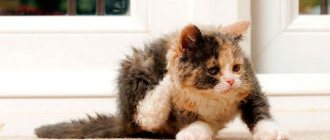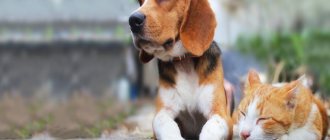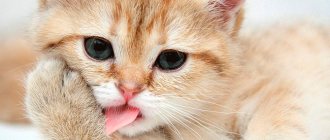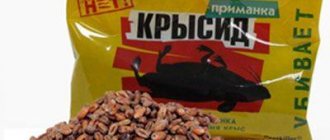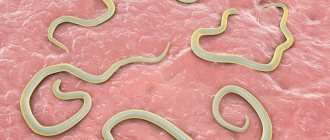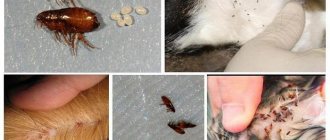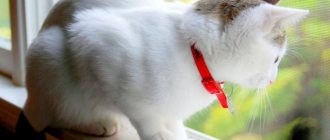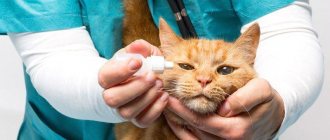Insecticides are dangerous to animal health. Therefore, when treating a cat with flea drops, there is a risk of poisoning. This is especially true for those owners who have several pets. After all, cats often lick each other and can accidentally swallow medicine. Let's find out what measures need to be taken to save animals in case of insecticide poisoning and whether it is possible to do without calling a veterinarian.
Causes of poisoning with flea drops
Most often, veterinarians indicate the following causes of poisoning in cats:
- Incorrect application of the product, namely smearing and rubbing concentrated solutions of insectoacaricides on parts of the cat’s body that are accessible to licking (belly, ears, inner thighs, tail root). The correct application of drops is pointwise in 1-2 zones along the spinal column, without rubbing. The drug spreads well and penetrates into the subcutaneous fat and hair follicles, from there it affects the tick and flea upon contact or bite.
- Treatment of weakened and sick animals, which is a complete contraindication for such manipulations. Since a small part of the active substances in flea drops still penetrates the bloodstream, a toxic effect on the cat’s liver and kidneys cannot be ruled out.
- Exceeding the dosage most often occurs when determining the pet’s weight “by eye”. Double or higher concentrations of the drug are considered dangerous. Therefore, animals need to be weighed periodically.
- The cat was washed a day after treatment, and she licked off the remaining flea drops. Poisoning occurs due to the fact that the flea remedy, which is not absorbed, is washed out over the entire surface of the cat’s fur, from where she licks it off.
- Use of canine products. Many drugs that are intended for dogs and cats are produced under the same name, but they often have different compositions. Due to cats' intolerance to certain insecticides, to which dogs do not have a similar reaction, severe poisoning may develop, even leading to death. Therefore, it is unacceptable to buy one product for different types of animals. If you need to save money, you should study the instructions for the drugs or check the name with your veterinarian.
- Handling kittens that are breastfed can be dangerous for the mother cat, as her constant licking of her babies may cause her to ingest chemicals from their fur.
- Individual intolerance to certain substances, which is typical for cats of decorative breeds. It is worth checking with the breeder about this when purchasing purebred kittens.
Careful use
Treating your pet with anti-flea drops
Manufacturers use insecticides of a certain dosage to make their products. A minimal amount is enough to eliminate fleas from a cat, but the dose remains safe for animals.
On a note!
The fact that it is recommended to drip in places inaccessible for licking is alarming: the area of the withers between the shoulder blades, along the spine. However, these recommendations relate more to the effectiveness of the product than to the safety of cats.
All modern drops for cats work the same way. Within 2 hours they are absorbed by the skin, localized in the hair follicles and sebaceous ducts. If the drops are licked off and do not have time to be absorbed, protection against fleas cannot be called complete.
Poisoning with FOS substances and carbamates
Organophosphates (diazinon, tetrachlorvinphos) and carbamates (propoxur) are considered obsolete and toxic agents for the control of insects and ticks in cats.
Since 2004, they have been used mainly in agriculture. However, some modern pharmaceutical companies continue to produce cat drops and flea collars with these substances due to their proven effectiveness and good sales. Examples:
- flea drops “Flea Drops” from Beaphar with the active ingredient diazinon (which are no longer sold in Russia, but are available in other countries);
- insecticidal drops “Best friend Ectostop” on diazinon;
- anti-parasite collars from Hartz (tetrachlorvinphos).
Several years ago in the Russian Federation, the drug “Dana” was produced with diazinon, but today the API-SAN company has changed the composition of flea drops (fipronil + auxiliary components).
Carbamates (propoxur) are present in some flea collars for cats from the Bolfo brand, and poisoning can occur if the cat licks or chews the accessory.
Clinical symptoms
If it happens that the cat licked the flea drops with diazinon, then clinically this is expressed by the following signs:
- excessive salivation from the mouth (a characteristic sign);
- lethargy, apathy;
- frequent urge to vomit (expressed as smacking and licking);
- loose stools;
- complete lack of appetite;
- muscle weakness and convulsive manifestations;
- rapid or, conversely, weakened heartbeat (depending on the dose);
- shortness of breath, rapid breathing with an open mouth;
- constant “small” trips and thirst.
A local allergic reaction is expressed in redness of the area where drops are applied, development of irritation, itching, and scratching.
Treatment
In such cases, the first thing to do is to prevent further absorption of toxins from the skin by washing off the product using a cleansing shampoo with a strong degreasing effect.
Next, it is recommended to rinse the cat’s mouth and stomach and induce vomiting by injecting a large amount of water. After washing, sorbents (activated carbon, Smecta, Enterosgel) are introduced.
If convulsions or muscle tremors appear, you should immediately take the cat to the veterinarian, he will administer intravenous anticonvulsants to reduce agitation and other necessary drugs (Atropine, Diazepam), prescribe infusion therapy and a therapeutic diet.
Visit doctor
After carrying out all the necessary manipulations, you should take the kitten to the nearest clinic. To simplify diagnosis and prescribe therapy, it is recommended:
- At the first symptoms of poisoning in a kitten, you should show it to a veterinarian
if possible, take with you a sample of the suspected poisonous product (a small portion of food or liquid, medication packaging, a sprig of a poisonous plant);
- collect the remaining vomit in a bag or sealed container;
- calculate the approximate amount of poison swallowed;
- remember and describe the stages and rate of development of symptoms, all manifestations of pathology, the presence of concomitant diseases or allergies to medications in the kitten;
- If you suspect intoxication with waste products of helminths, collect a small amount of feces.
The veterinarian will conduct a visual examination of the pet,, if necessary, prescribe laboratory and instrumental examinations and prescribe treatment. In severe cases, detoxification therapy may be required in the form of IVs or injections, as well as surgery.
Poisoning with pyrethrins and pyrethroids
Pyrethrins are insecticides of plant origin, which are obtained from certain types of plants (Dalmatian chamomile, chrysanthemum, tansy). In veterinary medicine, permethrin is actively used for cats (at 0.5-1% concentration in anti-flea shampoos, collars, drops, but in other proportions it is considered poison).
This is explained by the fact that in a cat’s body, permethrin does not break down into harmless compounds (as it does in dogs) and exhibits a toxic effect on the nervous system, which leads to prolonged convulsions and death.
This is why owners should be aware that permethrin dog drops should not be used on cats, as it can kill them.
Attention! If a cat licks flea drops containing permethrin applied to a dog upon contact, this will also cause poisoning. If a cat and a dog live together in the house, then it is better to buy insectoacaricidal products with other components.
Examples of existing products for cats with permethrin (their use is permissible only if the instructions are strictly followed):
- drops on the withers “Clandestine for cats” (1% permethrin);
- “Clandestine” universal powder (0.4% permethrin);
- spray "Clandestine" for cats and dogs (0.35% permethrin);
- anti-parasitic shampoos of the “Clandestine” brand (0.4% permethrin);
- anti-flea collars “Clandestine maximum” for cats (1% permethrin);
- “Pchelodar” – universal shampoo against fleas and ticks (0.25% permethrin);
- insecticidal shampoo for cats and dogs “Fitoelita” (0.3% permethrin);
- flea shampoo “Lapushka” (0.4% permethrin).
Pyrethroids are synthetic analogues of pyrethrins. Deltamethrin and etofenprox are used for domestic cats. Examples of drugs:
- Lugovoy shampoo for cats and dogs (deltamethrin 0.01%);
- drops for fleas in cats brand “Rolf Club 3D” (etofenprox 15%);
- butox 50 concentrate for preparing a solution (deltamethrin 5%).
Recently, due to frequent cases of poisoning in cats by these substances, many manufacturers of veterinary insecticides are discontinuing the production of certain drugs or replacing the formulation.
Symptoms
So, what happens if a cat licks flea drops that contain pyrethrins and pyrethroids:
- Half of the cats experience overexcitation, which is expressed in prolonged convulsions and twitching of the limbs;
- trembling;
- saliva is produced profusely;
- there is a loss of orientation in space;
- body temperature rises;
- pupils dilate;
- temporary hypersensitivity appears;
- coordination of movements is impaired;
- heart rate increases;
- gagging is observed;
- lethargic sleep may occur.
Therapy
Pyrethrins have no antidotes, so treatment is aimed at removing toxins from the cat's body.
If the poison has entered the digestive system, then you need to start with the administration of emetics or gastric lavage. At home, you should pour warm water into the cat’s mouth to induce vomiting, then give adsorbents (Smecta, Enterosgel).
If pyrethroids are ingested externally in a toxic dose (when treating a cat with dog drops), you need to wash the animal several times with regular shampoo and then feed it with adsorbents.
If a cat has licked off flea drops and has convulsive reactions, you should immediately go to the veterinarian, he will provide first aid, prescribe appropriate treatment, or leave the animal in a hospital under his supervision.
As a rule, cats recover in 3-5 days if first aid is provided to them in a timely and competent manner.
Development of nasal congestion
The nasal cavity is an area that is actively supplied with blood due to a large number of venous vascular sacs in the thickness of the mucous membrane. They are necessary to perform important functions - warming and humidifying the inhaled air. Due to some reasons (colds, allergies), swelling of the mucous membrane occurs, which leads to difficulty in nasal breathing and nasal congestion. In most cases, it is temporary and goes away with the use of local remedies, such as vasoconstrictor drops and sprays.
Poisoning with vegetable oil extracts
Some cat owners prefer to buy biological products for fleas, created on the basis of extracts of various plants (neem, mint, geranium, citronella, cloves, rosemary, tea tree, cinnamon). Such products effectively repel insects, but have virtually no effect on ticks.
Biological products are an excellent addition to classic insectoacaricides and can be the main method of protection for weakened, pregnant, lactating cats, as well as small kittens.
Examples of herbal drops on the withers:
- trademark GreenFort NEO (Ekoprom);
- a series of economical preparations Chistotel Bio (Ecoprom);
- line of VETO Pure Beaphar BIO products against fleas, ticks and mosquitoes with margosa extract;
- BIO series for cats against external parasites GAMMA;
- Good Dog Antiparasitic BIO drops;
- Natura Delix Bio Drops;
- ECO ZOOLEKAR BIO drops;
- Bio-drops AVZ “4 with a tail”;
- Drops "Rainbow BIO";
- Bio-Drops repellent Ms.Kiss;
- Flea remedy "BioVax-BIO".
However, a cat can also be poisoned by plant extracts if it ingests a large dose of the drug while licking its kittens or itself. For the first alarming symptoms to appear, a long-term interaction between the animal and the biological product is necessary (frequent treatments, a large number of kittens sprayed with the biological product, or a group of several cats that live in the same territory and lick each other).
There are pets with increased sensitivity to certain odors and extracts (congenital allergies), in which the first symptoms of poisoning may appear after a single treatment.
Typically, the problem of overdose with plant extracts is rare, and biological products have a short shelf life. Therefore, owners of city cats who take their pets out into nature try to apply drops or spray more often to avoid flea attacks.
You can also often read advice to cat owners on pet forums: “Treat your cats with biodrops every week or apply a herbal spray to their paws every day before walking outside.” Such advice contradicts the instructions for biological products, which leads to poisoning with plant extracts.
Signs of poisoning
If a cat manages to ingest plant drops against fleas, then after 30-50 minutes the following symptoms of poisoning will appear:
- excessive salivation (hypersalivation);
- refusal to eat for a day or more;
- lacrimation;
- vomit;
- muscle contractions, tremors;
- decreased body temperature (below 37.5);
- lethargy and apathy.
Deaths are quite rare with such poisonings, but are not excluded with prolonged low body temperature and decreased blood pressure.
Treatment methods
Treatment consists of eliminating severe symptoms and removing any remaining product from the cat’s fur. Namely:
- gastric lavage, stimulation of vomiting (pour in liquid, press on the root of the tongue with a spoon);
- soldering of adsorbents (activated carbon, Smecta, Enterosgel);
- drip infusion of nutrient solutions into a vein to prevent dehydration;
- for muscle twitching, Diazepam (a sedative) is administered;
- bathing in soapy water using a cleansing shampoo (to wash the drug off the skin and coat).
With this treatment, the animal will recover within 1-2 days.
Important! If a cat has an unusual reaction to a biological product, it is worth studying its composition and not buying analogues in the future.
Prevention
To prevent licking, apply drops according to the instructions.
If there are several animals, they are isolated or put on an Elizabethan collar. The insecticide is purchased in specialized stores. You should not use budget options. Advantage, Frontline or Advocate are effective and low-toxic drugs for killing fleas. Water deactivates the insecticidal effect of the drops, so the pet should not be wetted for the first four days.
It is unacceptable for the active component of the anti-flea agent to enter the bloodstream from the digestive tract. If a cat licks a friend treated against insects, it will be poisoned. In order for the contents of the drops to become insoluble, they must be allowed to dry. When there are several animals, they are isolated or an Elizabethan collar is used.
https://zelenplaneta.ru/blohi/chto-delat-esli-kot-slizal-kapli-ot-bloh.htmlhttps://notklop.ru/blohi/blohi-u-koshek/koshka-slizala-kapli-ot- bloh/https://apest.ru/blohi/blohi-u-koshek/koshka-slizala-kapli-ot-bloh/https://parazitdoma.ru/sovety/koshka-slizala-kapli-ot-blohhttps:// localvet.ru/koshki/simptomy/kot-slizal-kapli-ot-bloh
Drug treatment
Vasoconstrictors (decongestants) are drugs that have a local effect. When used, there is a quick and effective reduction in the swollen vascular networks of the nasal cavity and easier nasal breathing. These medications can be purchased without a doctor's prescription. There are many trade names, but there are only three active ingredients: oxymetazoline, xylometazoline, phenylephrine.
Side effects
If you do not consider the instructions for the drug Inspector as an unnecessary piece of paper, and spend time and your own attention studying it, then side effects and complications will not appear.
Rare case: skin reaction, expressed by redness of the application site and itching. Such unpleasant phenomena will pass quite quickly, without additional use of medications.
If this is an obvious allergic reaction, then the composition should be washed off the skin. To do this, wash the area with soap and clean water. The wool will need to be rinsed under running water.
An overdose of the drug and its consequences have not been identified. There are also no special manifestations during the initial use of the product or after its discontinuation. If the re-treatment period is missed for some reason, the medicine should be applied according to the previous dosage and the old scheme.
Contraindications
There are also contraindications for using Inspector on cats. In the first place is the identified individual intolerance or increased sensitivity of the pet to the substances of the solution.
Kittens that are not yet seven weeks old should not be treated either. Inspector is not contraindicated for a kitten older than this age.
The use of the drug on animals suffering from infectious diseases and those in the recovery stage is prohibited. It is also better not to disturb a cat that has recently given birth.
If a medicine with macrocyclic lactones is used in parallel, then taking the Inspector is prohibited.
It is prohibited to use the drug to treat ear mites if a perforation of the eardrum is detected.
